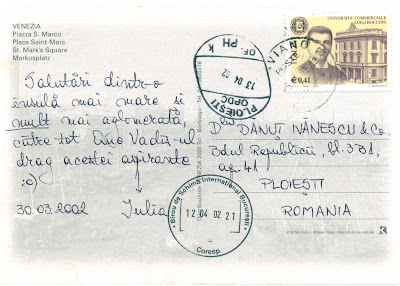October 9, 2011
0001 ITALY (Veneto) - Saint Mark's Square - part of Venice and its Lagoon (UNESCO WHS)
Piazza San Marco (Saint Mark's Square) is the main public square of Venice, so famous that he often is told simply Piazza. All other urban spaces in the city (except the Piazzetta and the Piazzale Roma) are called campi (fields). The Piazzetta (the Little Piazza) is an extension of the Piazza towards the Venetian Lagoon, and the two spaces together form the social, religious and political centre of Venice. The Square is dominated at its eastern end by the great Basilica di San Marco (Saint Mark's Basilica), about which I wrote here.
The Piazzetta dei Leoncini is an open space on the north side of the church named after the two marble lions (presented by Doge Alvise Mocenigo in 1722), but now officially called the Piazzetta Giovanni XXIII. The neo-classic building on the east side adjoining the Basilica is the Palazzo Patriarcale, the seat of the Patriarch of Venice. Beyond that is the Clock Tower (Torre dell'Orologio), completed in 1499, above a high archway where the street known as the Merceria leads through shopping streets to the Rialto, the commercial and financial center.
To the right of the clock-tower is the closed church of San Basso, designed by Baldassarre Longhena (1675), sometimes open for exhibitions. To the left is the long arcade along the north side of the Piazza, the buildings on this side are known as the Procuratie Vecchie (the Old Procuracies), built in the early 16th century. The arcade is lined with shops and restaurants at ground level, with offices above. Turning left at the end, the arcade continues along the west end, which was rebuilt by Napoleon and is known as the Ala Napoleonica (Napoleonic Wing).
It holds, behind the shops, a ceremonial staircase which was to have led to a royal palace but now forms the entrance to the Museo Correr (Correr Museum). Turning left again, the arcade continues down the south side with the Procuratie Nuove (The New Procuracies), designed by Jacopo Sansovino in the mid-16th century. Again, the ground floor has shops and also the Caffè Florian, a famous cafe opened in 1720 by Floriano Francesconi, which was patronised by the Venetians when the hated Austrians were at Quadri's. The arcade continues round the corner into the Piazzetta.
Opposite to this, standing free in the Piazza, is the Campanile of St Mark's church (1156-1173, last restored in 1514), rebuilt in 1912 after the collapse of the former campanile on 14 July 1902. The tower is 98.6m tall, and has a simple form, the bulk of which is a fluted brick square shaft, 12m wide on each side and 50m tall, above which is a loggia surrounding the belfry, housing five bells. The tower is capped by a pyramidal spire, at the top of which sits a golden weathervane in the form of the archangel Gabriel. Adjacent to the Campanile is the elegant building known as the Loggetta del Sansovino, built in 1537-1546.
This postcard also has one merit: back in 18th century, Canaletto, art master of urban perspective (pittore vedutista), looked at the scene from exactly the same angle, in not one but two of his paintings in 1723, respectively 1730, before his adventure to London.
Saint Mark's Square is part of the UNESCO World Heritage Site Venice and its Lagoon, about which I wrote here.
About the stamp
The stamp was isssued on January 24, 2002 (after a design created by C. Bruscaglia) to celebrate the 100th anniversary of the foundation of Università Commerciale Luigi Bocconi (Bocconi University). The university was founded in 1902 by Ferdinando Bocconi and was named after his son, who died in the Battle of Adwa during the First Italo-Ethiopian War (1895-1896).
References
Piazza San Marco - Wikipedia
St Mark's Campanile - Wikipedia
Sender: Iulia Anania
Sent from Venice (Veneto / Italy), on 30.03.2002
Etichete:
ITALY,
ITALY (Veneto),
Places I have been,
Places of worship,
stamps (complete series),
UNESCO World Heritage Sites
Locaţia:
Veneția, Italia
Subscribe to:
Post Comments (Atom)



ah, the day I sent you that postcard was also, alas, the only day I spent in Venice...
ReplyDeleteI also recall eating there the most expensive pizza of my life (15 euros).
:)
Maybe we have been both at the same bar?
ReplyDeleteI'm afraid not... :))
ReplyDelete